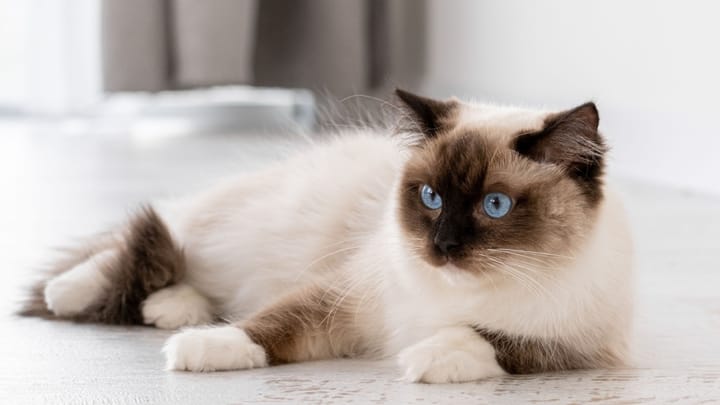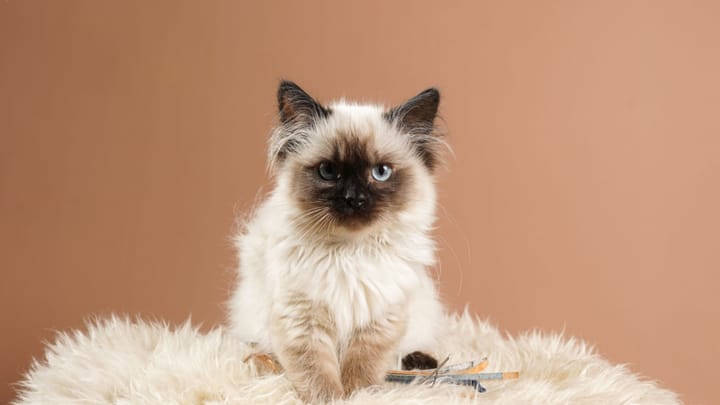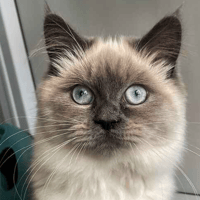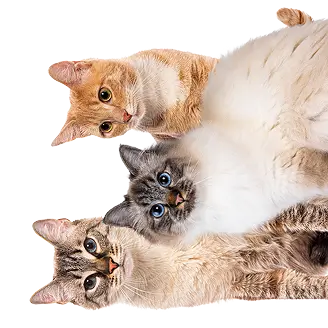Ragdoll


These good looking, blue eyed, and imposing cats are characterised by their elegance and gentle nature. They can relax their entire bodies when being carried, becoming almost totally limp, hence their name, “Ragdoll”!
|
Life expectancy |
The Ragdoll has a life expectancy of between 12 and 15 years |
|
Temperament |
|
|
Adult size |
Female
Between 12 and 14 in
Male
Between 13 and 15 in
|
|
Adult weight |
Female
Between 9 and 13 lb
Male
Between 11 and 20 lb
|
|
Coat colour
According to The International Cat Association (TICA) the accepted colours are seal, blue, chocolate, lilac, cinnamon, fawn, red and cream. |
Black Brown White Red Cream Blue |
|
Type of coat
Mid-length |
Long |
|
Eye colour
Intense blue is the only existing eye colour. |
Blue
|
|
Purchase price |
The Ragdoll costs between £400 and £700 |
‘Neoteny’ is one of the advanced hypotheses that explains the “Ragdoll” characteristic that these cats exhibit when being carried. This is where adults of any species retain traits from their childhood. In this case, kittens, when they are transported by their mothers, relax completely. This trait usually disappears with age in most cats, but for some reason, Ragdolls have retained this trait into adulthood.
More details about the Ragdoll
Ragdoll: Origins and history
Originating in America, Ragdolls were first created in 1963 by Ann Baker, who bred black Persians. She crossbred a male seal point cat with a Turkish Angora cat, with long white hair and intense blue eyes. Due to the docile temperament of these cats, Ann Baker decided to name them "Ragdoll". Other breeders, such as Denny and Laura Dayton, developed the breed further and worked towards getting it recognised. It was accepted as a breed by TICA in 1979 and by the International Feline Federation in 1992.
Physical characteristics of the Ragdoll
Ragdolls are large, well-built, long, and strong cats supported by strong, muscular medium-length legs and topped off with long, thick, plumed tails. Their heads are triangular but have rounded edges and their noses are slightly sunken. Their muzzle and chin are well developed. They have medium sized ears, which are broad at the base and rounded at the tip. Their eyes are large and oval-shaped, and are slightly slanted.
Ragdoll: Characteristics
Ragdoll: Behaviour
Breed compatibility Ragdoll
Ragdoll: Purchase price
On average, they cost between £400 and £700. Their price varies depending on their lineage, breeding, age and sex. It also costs around £35 / month to provide for them, making sure they get good quality food and keeping them in good health.
Ragdoll: Shedding
Light
As their undercoat is so thin, if they’re brushed regularly (once a week), they won’t lose much hair.
Ragdoll: Grooming
Their fur is composed of mid-length hair and only a light undercoat. Fortunately, it doesn’t knot and thus a simple weekly brush is sufficient.
Ragdoll: Health
They live 12 to 15 years on average.
They’re relatively robust and adapt well to most climates.
Due to their low activity levels, you must pay attention to the amount of food their eating each day.
Ragdolls can suffer from hypertrophic cardiomyopathy and (more rarely) from polycystic kidney disease. Both diseases can be detected using genetic tests.
- Hypertrophic cardiomyopathy: a disease that affects both non-pedigree and pedigree cats and eventually causes heart failure.
- Polycystic kidney: a disease that causes liquid-filled cysts in the kidneys, ultimately causing incurable renal failure.
Only breeding with other Ragdolls is permitted.
Like all other colourpoint breeds, their kittens are born completely white.
Do you want a Ragdoll cat ?
Frequently asked questions
How much does a Ragdoll cost?
The price for a Ragdoll will vary according to its lineage, breeding, age and sex. On average, they cost between £400 and £700.
To make sure this cat breed gets good quality food and is healthy, it will cost approximately £35 a month.
Can Ragdoll cat be left alone?
Yes Ragdoll can be left alone but not for long periods of time. This cat breed actually has a low tolerance to solitude so leaving them for a whole day would be fine but not more.
Find out how long you can leave your cat alone.
Why are Ragdoll cats so friendly?
The Ragdoll cat is known for being one of the most sociable, friendly and affectionate cat breed. They absolutely love being in the company of humans and likes to get all the attention. Ragdolls have actually been named like this because they can relax their entire bodies when being carried, becoming almost totally limp.
How long do Ragdoll cats live for?
The life expectancy of a Ragdoll is between 12 to 15 years.
Do ragdolls make good indoor cats?
The Ragdoll is an easy-going cat that just loves being around its family. This laid back pet isn't super adventurous and would largely prefer to chill on the sofa rather than exploring its horizon. Actually, Ragdool are usually kept indoors. Indeed, they were bred for being an indoor cat and therefore they tend to trust everyone which can lead them into danger. Last but not least, they get on well with other cats, dogs and children. So yes, Ragdoll cats are good indoor cats.








